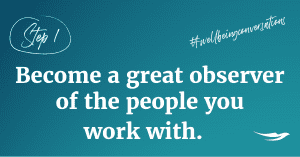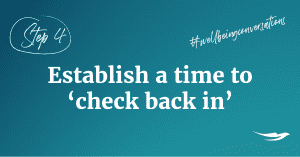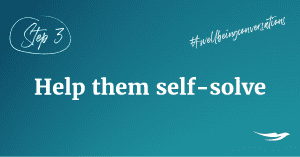Wellbeing Conversations Change Lives!
Top Trending Posts

In Australia, a joint statement from the Australian Medical Association in May 2020 anticipated an increase in youth suicide and increased demand in the space of mental health services.
In the course of our practice, this week alone, we have had more than 20 discussions that point to wellbeing concerns and made referrals to numerous specialists as appropriate.
Part of what we are discovering is that it’s hard to know if someone’s wellbeing is at risk, particularly if that person is socially isolated. It takes a keen listener and observer to ‘pick it’ and sometimes a direct conversation to reveal what’s really happening for the other person.
You don’t need to be a mental health practitioner to have an effective wellbeing conversation. You simply need to care, have a few questions to start, listen well and, if something does happen to come up, support that person to choose a next step.
What we want to offer is an effective way to have a Wellbeing Conversation so that you and the other person feel comfortable to speak about what’s happening for them and create a space where they can identify where they’re at, express any concerns, share possible ‘steps’ forward and make a commitment to action in the near future.
If you’re that person that cares, or has noticed changes in the way someone close to you is interacting or behaving, try these orientations to begin:
Step 1
Get clear on what you’ve noticed is different. This can be a good lead in. You might start with that observation and offer the observation tentatively. “Hey, I’ve noticed that you’ve stopped using your camera for our Zoom meetings” or “In the past few weekly meetings, I have noticed you haven’t spoken much.”
If you have not noticed anything is different, and still want to have a check-in chat, start with general questions like “how are you doing?” or “how are you coping with the changed working arrangements” or “how are things going working from home?” These general questions can help open up a space where the other person does not feel like you’re prying, since they’re quite generic.

Step 2
Listen! Listen to what they say, how they say it and see if you notice anything about the way they share that indicates they’re going well, or perhaps that something’s not going well! It can be helpful to paraphrase, so they know you’re truly listening and that you’ve understood what they’re sharing! Spend more time listening than speaking at this point. You might even ask some clarifying questions if things are unclear for you, just so you understand.
Step 3
Help them self-solve. Most of us are not counsellors and that’s not the purpose of this conversation. The purpose is to open up a space of safety and care to allow the other person to share, and this step is all about helping that person self-solve, identify some ways forward or above all, find the appropriate person to speak with. You might ask “is there someone you’ve been speaking with about this?” or “do you have access to a counsellor or EAP (Employee Assistance Program) service?” or “have you had a chat with your GP about this?” and “are there any strategies you can think of to help you navigate (insert the concern)?”
Again, the idea here is NOT to solve what’s going on for them, but to help the other person identify their own options and commit to taking a step forward. Providing advice can be far less helpful since it takes away the other person’s self-solving capacity. If, however you have a grave concern, you might steer them towards professional services like Beyond Blue, Lifeline and Headspace.
Step 4
Establish a time to ‘check back in’. This can be a really critical step to helping that person take action based on their own ideas. You might say something like “I’ll call you in a couple of days to see what you’ve been able to find” or “I’m looking forward to hearing how ‘x’ goes for you”. It can also be helpful if they’re a close person to offer “hey, please reach out if you need someone to listen”.

There are commonly agreed indicators of health and wellbeing. You might mention some of these during the course of your conversation and listen to the possible ‘absence of these’ in your conversations.
When wellbeing is working for us:
- We have supportive relationships with family and friends
- We engage in quality conversations that satisfy our desire for meaning and connection.
- We have a sense of meaning in what we do in our career and life.
- We are moving regularly and exercising.
- We are eating well and supporting ourselves with nutritious food.
- We have a generally optimistic outlook, and even if we experience hardship, we can see a way forward.
- We have a sense of where we are headed, and even if we are a little delayed, we can see the bigger picture.
- We demonstrate a capacity to adapt to change, like working from home and we employ strategies to support ourselves to adapt well.
- We rest and sleep well and have strategies for effective ‘wind down’ at the end of the day.
Of course, no one of these factors alone constitutes wellbeing. It is the confluence of these that really has us sense that ours, or another’s wellbeing is stable.
For any Wellbeing Conversation you initiate, we equally encourage you to reflect on your own wellbeing as you check in on another’s. As you listen, your own concerns and provocations can be triggered, so pay attention to your concerns and reach out to another if your personal wellbeing feels at risk.
Here’s another take on how you can build wellbeing in your social circles. Make it a group thing, not merely a one on one pursuit.
There are groups of people Tony I have relied on above all others in these pandemic times. They existed before Covid and they will exist afterwards – and through Covid, we are bonded as friends for life. They are people Tony and I study with and existential friends that explore and create a sense of purpose and meaning in our lives. We meet every week and we talk about our personal and business experiences. There’s no judgement in this space, just listening, care and an appropriate level of challenge to ensure we are in ‘good spaces’.
Our ‘teams’ have shown us the power of conversations. Conversations for learning. Conversations for reflection. Conversations to explore complexity and make sense of what we cannot understand on our own. We need the pluralistic view. Conversations of inspiration and hope. Insights from colleagues and friends in five other countries that help us have a sense of relativity and gratitude for our predicament here.
Of all these conversations however, one has emerged as the most crucial. A Conversation for Wellbeing.
When Tony and I utilise video conferencing, it takes just a moment to observe how another person shares or to listen to the language they use to describe their world, to realise they’re well and going well, or that their wellbeing is at stake.
It’s funny that our life journey to now feels like it has been shaped to this very conversation in this very moment. We can all be of service as we grapple with new questions in this strange pandemic age. Again, just one conversation you have might change (or save) a life.
If you’d like your leaders to initiate these conversations, please let us know. We have developed specific Programs to equip people leaders to conduct these safely and with effective referral points. Click HERE to see our latest programs.
Share This
Top Trending Posts
Sign Up
to our blogs and receive regular updates.

Stay in the Conversation
with Liberated Leaders...








